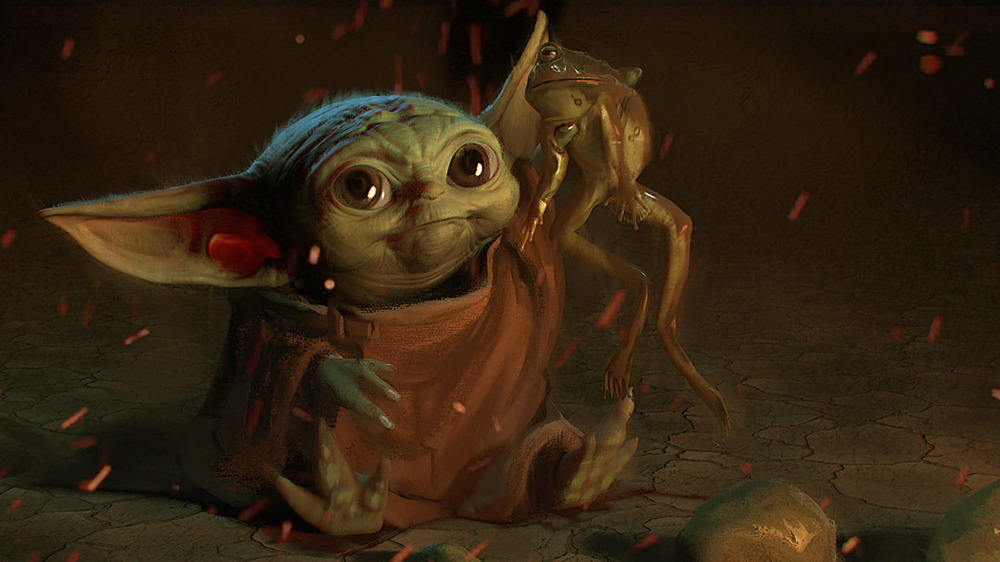The Subtle Jon Favreau Touch You Never Noticed In The Mandalorian - Exclusive
Is The Mandalorian a galaxy-hopping adventure that takes Din Djarin to the most remote corners of the Star Wars universe, or is it really just a quest to get Baby Yoda fed? After all, it doesn't matter if you're talking about a hearty bowl of soup, blue macarons, or the last batch of a poor alien's eggs – if it's edible, it's going to end up in Grogu's mouth eventually.
In fact, The Mandalorian has a big focus on food in general, which is just one of the reasons why it's unique among Star Wars media. Outside of Disney's theme parks, where visitors can chow down on in-canon treats at Star Wars: Galaxy's Edge, and the occasional glass of colored milk, we haven't really seen what people eat or drink in the galaxy far, far away.
So, what makes The Mandalorian different? According to Phil Szostak, Lucasfilm's creative art manager and author of a number of behind-the-scenes Star Wars books, including the recently released The Art of Star Wars: The Mandalorian, it's Jon Favreau, the filmmaker who created the hit Disney+ series.
"I do love Jon Favreau's emphasis on food in The Mandalorian, from spotchka to the Child's soup," Szostak tells Looper in an exclusive interview, "which I believe stems from Jon's love of cooking."
As Szostak notes, Favreau is a well-known foodie, and learned how to cook from celebrity chef Roy Choi while filming his 2014 passion project Chef. Favreau and Choi became close friends as a result. In 2019, they teamed up to launch The Chef Show on Netflix, in which the duo embark on culinary adventures around the world while trying out new recipes and mingling with both celebrities and culinary superstars.
In Szostak's words, Favreau brings that same enthusiasm to the Mandalorian set. "He gave very specific notes to the artists regarding the design of food — something rarely seen or emphasized in Star Wars," he says. It's that kind of attention to detail that makes The Mandalorian so special. Whether it's a hulking Imperial spaceship or a simple meal, everything feels completely lived-in and fully realized.
Why The Art of Star Wars: The Mandalorian is different from other Star Wars art books
It's not just the food, of course. While reading The Art of Star Wars: The Mandalorian, one of the most striking themes is how specific Favreau's unique vision for the show is, and how well he communicates his ideas to Lucasfilm's designers. In most of Szostak's other art books, you can see how Lucasfilm's artists iterate on ideas over time, producing multiple concepts before they get close to the designs that eventually appear on screen. In The Art of Star Wars: The Mandalorian, characters, vehicles, and locations appear almost fully formed. Most of the time, the original designs only differ slightly from what ends up on the show.
According to Szostak, that's pretty standard for The Mandalorian. "For me, the most surprising thing [about working on the show] was the incredible amount of design work that was accomplished in an extremely compressed schedule and at such a high quality," Szostak tells Looper. "And it's something you only realize in hindsight."
Highlighting a specific example, Szostak calls out the artwork that appears during The Mandalorian's credits' sequence, which depicts scenes from the episode that just ended. "Many fans on social media assume that the concept art featured in the end credits of The Mandalorian are paintings of scenes from the episodes after they are shot. But they were all completed months prior to each episode's filming," Szostak explains. "The shots match the art, not the other way around."
That's a pretty remarkable achievement — especially given the quick turnaround time a TV show schedule dictates — and it speaks very well of both Favreau's vision and the skill of the artists working at Lucasfilm. The Mandalorian may take place in a familiar setting, but as The Art of Star Wars: The Mandalorian proves, there's never been a TV show that looks quite like this one.
The Art of Star Wars: The Mandalorian is available now.

